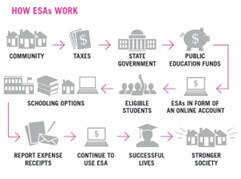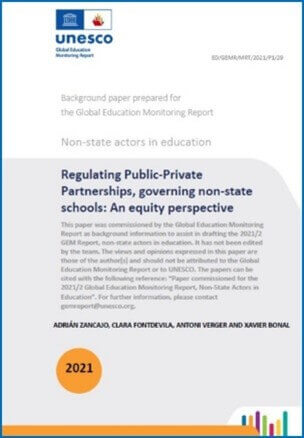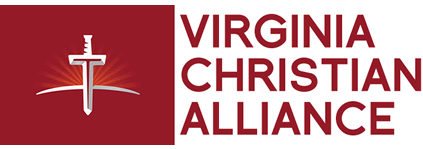Playback speed:
By Sandy Szwarc
© Szwarc 2025
Where do you stand on the school choice issue? If you are a Christian parent trying to faithfully follow Biblical teachings, your position will be very different from those with secular worldviews. The school choice debate currently raging across America is a profound test of Christian parents’ faith.
Today is the final exam.
Biblical teachings, commanding fathers with the responsibility of teaching their children, and training them in the way they should go, were nearly abandoned in America a century ago. The lure of “free” government subsidized education led parents to turn the education of their children over to the state. The state, in control of the purse strings, then controlled what all children in public schools were taught, what they would be permitted to think and believe, and what they must do…with the goal to transform America to socialism.
“School choice” is the last round to coerce the parents who have resisted government schooling to get on board. Once again, the lure is “free” subsidized education.
What does “School Choice” really mean?
School Choice is a lobbying term. It refers to various programs that are marketed as giving parents a “choice” in how their children are educated. In reality, however, all of these programs as legislated across the country are actually about how government (taxpayer) money is spent for education.
School choice programs all work to normalize the idea that education is a responsibility of the government rather than parents.
They are essentially new welfare programs, increasing the number of families dependent on the government, increasing state education budgets, increasing the size of state education administrations and the number of state employees, and expanding government control over education. Worse, those expanded state education budgets primarily benefit vested interests − those powerful, politically-connected, private-public partnerships of stakeholders and teacher unions.
Of the various school choice programs currently run by states: 20 are “Education Savings Accounts” (ESAs), 20 are voucher programs (sometimes nicknamed opportunity scholarships), 25 offer tax credit programs that allow corporations or families to write off approved educational expenses; and 17 have no private school choice programs.
The concept of school choice first entered public policy debates in the 1950s as a concept of “public good.” – “goods and services that produce benefits to the collective and individuals,” according to the Manhattan Institute. Milton Friedman referred to the common need for an educated citizenry in a democracy and believed that if left to the private market alone, people might not avail enough education to fulfill this common need. As a result, said the Manhattan white paper, he supported universal public financing of education to “deliver some common set of values and a minimum degree of literacy and knowledge on the part of most citizens.” By the 1970s, calls for equity, equalizing family power, and social justice moved most school choice programs to non-universal financing.
Nationwide, only 15 states have universal school choice. In universal school choice programs, all students qualify, regardless of family income, location, demographic, or disability. Its proponents argue that education should be a free market for all families unburdened by excessive state regulations, with all parents having input and a voice. The glaring fallacy, of course, is that there is nothing “free market” about programs involving government money.
Non-universal school choice programs are only open to qualifying students − usually low income, minorities, those with disabilities or special needs, living in certain districts or attending certain schools. These essentially redistribute public funds in attempts towards equity and fairness, and are promoted today by progressives and teacher unions.
School vouchers give public education funds to parents that can only be spent at participating private schools. ESA’s are a form of vouchers where public funds are put into a government account that may be used by parents for “approved” educational expenses (such as private school tuitions, tutoring, online courses, and home school curricula).
While individual states each have their own set of guidelines, both voucher and ESA programs operate and are funded similarly. They stipulate that public funds pay for third-party private contract managers, called “certified educational assistance organizations” (CEAOs), that hold state money in trust, manage applications, and distribute payments to parents for approved expenses. There’s big money and politics behind who gets these state CEAO contracts.
ClassWallet, based in Florida and established in 2014, is the largest CEAO and has focused its business on the school choice market, heavily lobbying state legislators and state public school administrators. Its lobbyists have succeeded in getting contracts with education departments in 32 states managing over $2.7 billion in public funds. The school market enabled the company’s business to increase 700% and its transaction revenue to triple between 2020-2021.
With little or no government oversight, ClassWallet has been immersed in fraudulent ESA payments in multiple states. In Arizona, fraudulent ESA payments were made for ski passes and golf equipment, and two Colorado residents had collected $110,000 in fraudulent ESA payments for 50 children, 43 of whom didn’t exist.
Oklahoma had contracted with ClassWallet to manage the $17.35 million Governors Emergency Education Relief funds in 2020 but ClassWallet became embroiled in over nearly half a million dollars in questionable spending found during a Federal audit, while also continuing to operate on an expired contract, according to Oklahoma Watch.
ClassWallet currently has three lobbyists working Virginia politicians on education procurement opportunities and four working in Texas, for example. Virginia Department of Education contracted ClassWallet to administer up to $30 million in EANS Funds.
Texas Education Association (TEA) also contracted with ClassWallet to handle Texas’ Special Education Services program, charging a 2.5% service fee for its Pay Vendor portal. TEA, headed by a Commissioner appointed by the Texas Governor, is the state agency that oversees all K-12 public education, funding, testing and assessment and accountability programs, accreditation of statewide curriculums and programs, data collection and regulatory compliance.
Last week, the Texas legislature voted for school choice and simultaneously approved the state’s largest budget in its history at $337.4 billion (nearly $48 billion in new spending, even though the state has record revenue and a historic $80 billion budget surplus from over-collected taxes from taxpayers). Its K-12 public education budget also increased the base amount per student by 13.6% over the 2025-2026 budget, even though public school enrollment has been declining several years.
If you guessed politics are big in Texas, you don’t know the half of it. Even before this latest legislation, Texas’ spending on public education was already more than the entire state budgets of 45 states, according to TPPF. Public education has long been the state’s top spending priority, accounting for $38.2% of the 2024-25 state’s general revenue budget. Schools are not underfunded in Texas. According to TEA, the total operating expenditures for the 2022-2023 school year were over $92.4 billion, which was $16,792 per public school student.
Not a single Texas politician made the Biblical case against school choice. Instead, politicians created a new education account of $1 billion to fund ESAs, along with allocating an additional $7.7 billion towards public school education (to appease the unions). The school choice legislation will also use public funds to pay as many as five CEAOs up to 5% of the appropriated educational funds, which equates to tens of millions of dollars in profit for these companies.
The specifics of the legislation translates to the state Comptroller becoming headmaster over all students in the program, controlling all education vendors, admission priorities, testing mandates, and spending. It also means it will not be a universal program and very few of the 350,000 students in private schools or the 750,000 homeschool students will have access to the school choice program, said Bill Peacock, former Vice President of Research at the Texas Public Policy Foundation (TPPF).
“School Choice” means less choice
The issue of eligibility of religious school education for school choice funds was settled in three Supreme Court rulings, according to the Manhattan Institute. Nonsectarian status for fund eligibility was also ruled an unconstitutional violation of the Free Exercise Clause of the First Amendment, enabling access of school choice funds equally to religious schools. While a state is not required to subsidize private educations, reported the Manhattan white paper, “once a state decides to do so, it cannot disqualify some private schools solely because they are religious.”
However, all school choice programs because they use state funds are also subject to state regulations and accountability, Manhattan Institute confirmed. “Free money” from government always comes with strings: required compliance to government “quality measures,” curriculum and textbooks determined by the government, testing and reporting mandates, and oversight. Whatever the government funds, it controls.
Rallying cries for school choice to enable parents to choose private or homeschool education options for their children are Trojan horses. Certainly, private and Christian schools and homeschooling can offer education more closely aligned with parental values and less inundated by progressive ideologies, while escaping a lot of state regulations, especially concerning textbooks, curriculum, records, and student testing compliance. However, as soon as state public money gets involved, the state becomes an interested party, with a “compelling state interest, according to constitutional lawyer William Bentley Ball.
Under school choice, as soon as government money is accepted, private, charter, church and even home schooling will become de-facto public schools under the government.
That’s what is meant by the statement that the final result of school choice is less choice in K-12 education.
“School Choice” lobbyists play both sides of the debate
The school choice lobby is massive. In Texas, for example, there are twelve public education lobby associations with 86 register lobbyists, according to the Texas Ethics Commission. In addition to this army of hired public school lobbyists working the Texas Capitol, 27 school districts also hired their own lobbyists in 2024, according to Texas Conservative Research Institute. Lobbying is marketing, media and polling is marketing, and disinformation abounds.
You can tell who stands to benefit by observing who supports school choice. Private schools and homeschool providers lobbying for school choice see it as a way to gain more students and raise revenue. Most fail, however, to acknowledge the risks of accepting school choice benefits to parents who want freedom from government control over their children’s education, or freedom from the woke ideologies infecting today’s public-funded education.
Globalist interests are shrouded in both opposition and support for school choice. NEA and teachers groups are the largest vocal opponents of anything that touches their public school gravy train. They are also, however, either poorly informed or intentionally deceptive about their opposition to school choice. That’s because it’s well recognized – across the country and around the world − that school choice legislation increases government control over education, and that those education departments and government agencies in control promote the very progressive policies and globalism ideologies supported by the unions. They’re all on the same team, in actuality.
As we’ve seen, globalists have also lobbied hard for school choice in order to move more public money and influence to the private and charter schools they support, where their progressive ideologies are imposed.
School associations, with significant influence on curriculums, school policies, and school accreditations, also lobby legislatures and politicians for school choice. School choice legislation will mean more parents will have no choice but to comply with their guidelines. The largest associations for private and even Christian school accreditations, in fact, comply with the United Nation’s and UNESCO’s globalist ideologies in school curricula. That includes the Association of Christian Schools International (ACSI).
 So, not surprisingly ACSI and its Public Policy & Legal Affairs division, has been a leading lobbying group calling for school choice and pushing for government funds for private and alternative schools. It networks heavily with U.S. state legislative politicians and is allied with EdChoice, the Friedman Foundation policy group that’s worked for universal state funded school choice programs since 1996. EdChoice 101 states that through taxes, state governments provide public education funds for eligible students and the results are “successful lives” and a “stronger society.”
So, not surprisingly ACSI and its Public Policy & Legal Affairs division, has been a leading lobbying group calling for school choice and pushing for government funds for private and alternative schools. It networks heavily with U.S. state legislative politicians and is allied with EdChoice, the Friedman Foundation policy group that’s worked for universal state funded school choice programs since 1996. EdChoice 101 states that through taxes, state governments provide public education funds for eligible students and the results are “successful lives” and a “stronger society.”
Accountability and transparency
ESAs and vouchers are still relatively new and evolving. The year 2023 saw historic growth of school choice programs, as parents rebelled from public school policies such as DEI, racial quotas and gender identities; the government’s response to a virus of school closures and digital learning; and failing academics, according to Manhattan Institute. That year, seven states adopted new choice programs and another 12 expanded existing ones. However, along with that growth came arguments for accountability and that “school choice programs should be designed to help parents ‘make good choices,'” and make parents “instruments of accountability.” All but two states required annual state testing and reporting to the state education department.
The newness of school choice means there is little systematic evidence yet, according to a policy analysis by WestEd. However, the inevitability of government control is clear. Under federal law, states are required to have accountability systems in place for all public-funded schools, including reporting student outcomes. As state policymakers focus attention on accountability of ESAs and how public money is spent, states will address academic, financial and data/reporting accountability, the analysts said.
School choice programs will be called upon to ensure that taxpayer funds are spent on items that offer “educational benefit,” WestEd said. [They’re often called “quality measures.”] Already, several ESA statutes require parents to agree to only use funds on state-approved core academic subjects; 14 require state or national assessments to monitor learning; and nearly all require audits and data collection and reporting of interest to stakeholders and the public.
Public school proponents and NEA teacher unions lobby that anyone receiving public money for education should be under the same regulations as public schools. Last year, for example, Arizona governor increased accountability and transparency in its ESA voucher program to hold private school expenditures to the same standards as public schools.
The most formidable evidence of the enormous political power behind government regulation of any private school, religious school or homeschooling program − as soon as school choice is enacted and public funds are used − was in the policy white paper issued by UNESCO.
 Its paper on governing publicly funded private schooling was commissioned by the Global Education Monitoring Report and outlined the regulation and accountability policies necessary to promote equity. International agencies with the United Nations, including the World Bank Group, and international stakeholders such as the Global Partnership for Education, OECD, and UNICEF, have been part of the adoption of these educational public-private partnerships, including in the United States and England.
Its paper on governing publicly funded private schooling was commissioned by the Global Education Monitoring Report and outlined the regulation and accountability policies necessary to promote equity. International agencies with the United Nations, including the World Bank Group, and international stakeholders such as the Global Partnership for Education, OECD, and UNICEF, have been part of the adoption of these educational public-private partnerships, including in the United States and England.
According to UNESCO, autonomous public-funded private and home schools are not exempt from complying with centrally defined curriculums, learning standards or student admission criteria, among other public regulations. Accountability frameworks play a strategic role in promoting that all publicly-funded schools, independently of their ownership, are correctly aligned with quality standards and also with the equity goals and objectives set by the government.” Its proposed regulatory strategies included everything from authorization of providers, fees and caps, admission criteria, evaluations and testing, teacher qualification requirements, and monitoring and surveillance.
Last September, the National Education Policy Center at the University of Colorado-Boulder (NEPC), issued its policy recommendations on oversight of ESA funding for private and home schools. NEPC is funded by various governmental organizations, NGOs and foundations, including NEA, AFT, Ford Foundation and others. It not only opposes universal school choice, it lobbies for public education and globalists’ UN’s sustainable development goals, along with over 380 other members of the Global Campaign for Peace Education.
NEPC’s recommendations to policymakers include: eliminating universal eligibility for ESA programs to prioritize low-income and disabilities to promote equity; limit eligible expenses and pursue sanctions for ineligible purchases; collect and publicly report data on all students receiving ESA funds; conduct annual studies; mandate academic testing and require state “norm-referenced assessments of all ESA recipients;” and “extend accountability and quality measures that govern public schools to all participating private schools, virtual schools, and homeschool settings.”
It is doubtful that any state legislature or school district or governor will stand up against these political interests.
Parents accepting school choice government money will have little power over government regulations of their child’s education. Taxpayers without children, such as elderly, will continue to be forced to pay for secular or poor-performing public schools and school policies. No taxpayer will be able to control how their hard earned money will be used towards educating America’s children.
In reality, “school choice” vouchers and ESAs are all sleight of hand, back door, ways to grow government, expand government budgets and taxes, and increase government control over K-12 education.
School Choice for Christian Parents – Part 2, looks at the benefits of home schooling and caveats in school choice.


